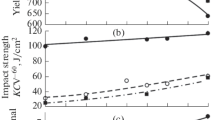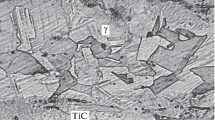Conclusions
Reducing the oxygen content from 0.08 to 0.006% in steel 000Kh28 (vacuum induction melt) eliminates susceptibility to high-temperature embrittlement and has no effect on susceptibility to intercrystalline corrosion, although it has a substantial effect on embrittlement after high-temperature quenching.
Similar content being viewed by others
Literature cited
L. Colombier and J. Hochman, Stainless and Heat Resisting Steels, rev. ed., St. Martin (1968).
V. S. Mes'kin, Fundamentals of Alloying Steel [in Russian], Metallurgiya, Moscow (1962).
Ya. M. Bokshitskii, Stal', No. 6 (1958).
Additional information
Central Scientific-Research Institute of Ferrous Metallurgy. Translated from Metallovedenie i Termicheskaya Obrabotka Metallov, No. 4, pp. 54–55, April, 1971.
Rights and permissions
About this article
Cite this article
Zhadan, T.A., Ustimenko, M.Y. & Medvedev, É.A. Effect of oxygen on the structure and properties of high-chromium steel. Met Sci Heat Treat 13, 321–322 (1971). https://doi.org/10.1007/BF00661347
Issue Date:
DOI: https://doi.org/10.1007/BF00661347




